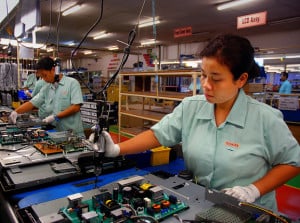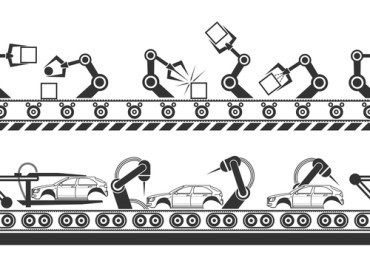
An Industrial Internet Consortium testbed looks to bring visibility to the factory floor. Here’s how:
A new factory testbed launched under the aegis of the Industrial Internet Consortium (IIC), in partnership with Fujitsu, seeks to improve “factory visualization” of Internet of Things (IoT) deployments within the manufacturing industry.
The Factory Operations Visibility and Intelligence (FOVI) model was developed through Fujitsu’s field trials and know-how gained in its own production facilities, and is intended to support the widespread use of IoT in production facilities. The factory testbed is intended to bring visibility to production facilities, and uses the cloud to integrate a variety of data, such as operating information captured in real time from sensors attached to equipment, as well as related production plans and work results.
[ Related: 7 IIC Testbeds Offer a Look at the Future of the Industrial IoT ]
Fujitsu designed the factory testbed so that multiple companies, each in their own specialized fields, can collaborate and build an ecosystem of sensors, analytic applications, and other technologies.
“The initial focus of the FOVI testbed is on manufacturing and repair of complex, composite products such as IT equipment including notebooks and network appliances,” according to Jane Yin, vice president of marketing and the open innovation group for Fujitsu Laboratories of America, Inc.
The project’s planners hope to explore a wide range of opportunities to increase manufacturing efficiency, she adds. “The FOVI model is flexible regarding the areas of manufacturing operations that can be explored. Experience from existing factory environments indicates that bottlenecks and delays are key contributors to reduced efficiencies and will be included in the initial areas of concentration.”
Factory Visualization
Fujitsu proposed its IoT solution model, under the theme of factory visualization, based on the field trials and know-how gained at Fujitsu I-Network Systems Limited’s Yamanashi Plant and the production facilities of Shimane Fujitsu Limited. This is IIC’s first testbed in Japan.
The FOVI testbed aims to use IoT to make it easy to bring visibility to production facilities, to enhance worksite activities, raise motivation toward work, and to quickly evaluate the effects of cost reductions. In addition, since it has been approved as an IIC testbed, companies with a variety of technologies will be able to develop added value, such as, for example, analysis functions for making production lines more efficient.
With other companies, Fujitsu will be evaluating field trials, planning a common architecture, and building and testing prototypes, to create a testbed with high interoperability which customers can test in a short period. Furthermore, the company aims to strengthen solutions to respond to all types of needs, incorporating the know-how gained from these efforts.
“Anticipated benefits will include more timely product manufacturing and shipment from process optimization,” says Yin. FOVI’s proponents also hope to see “better analysis of inefficiencies and causes of defects, reduced rate of product rejection, faster product repair, and related cost savings, enhanced product quality and production throughput, ability to handle higher volumes.”
As an example, Yin says, “a Fujitsu factory had assumed that outages of masking printer machines for electronic circuits would be negligible when compared to the outage time for high speed mounting machines. The data shows that the masking printers actually accounted for 16% of the overall outage time, which is something that wasn’t expected.”
Additionally, she continues, “the time spent to confirm the effects of a remediation measure can greatly be reduced. The same factory mentioned above was able to improve the remediation confirmation time by 15% to 30%, allowing the team to move on to the next action sooner.”
Factory Testbed Flow
The testbed is designed to collect sensor data generated on the factory floor, production-equipment logs, production plans and statistics, operator information, and to integrate all this and other related information in the cloud. In this way the testbed can be used to bring visibility to production facilities, analyze and predict outcomes, and support better decisions for improvements.
Because the current status can be digitally shared with all relevant people, it is possible to speed up improvement tests on the spot, and to propose optimal methods based on comparisons with other departments or factories. In this way it can be used to dramatically reduce operator-hours for automated production processes in small-lot manufacturing, or for manual processes in product reworks, as well as contribute to creating optimal team organization and human resource development.
Human operators and employees will see dramatic improvements in their jobs, Yin says. “Human operators and employees will benefit from improved efficiencies (up-time) and less frustration (employee satisfaction), enabling them to meet (or exceed) their production targets,” she states. “Collecting data is painful work to verify the efficiencies of their Kaizen activities. FOVI will eliminate those efforts by providing visualized factory status almost on time so that the employee can focus on the counter measures.”
Other Testbeds
IIC testbeds bring together collaborating companies and customers from among 200 participating companies to build an ecosystem, where a vendor takes initiative to build a solution and works with collaborating companies to pursue test projects and implemented projects for real customers. IIC also oversees a number of other testbeds geared to specific functions. Those include the following:
- Asset Efficiency Testbed
- Condition Monitoring and Predictive Maintenance for monitoring machine health
- Communication & Control testbed for energy microgrid applications
- High-Speed Network Infrastructure for introducing 100 gigabit-per-second connectivity between systems and devices
- A Track and Trace (T&T) testbed for managing power tools
- Infinite (International Future Industrial Internet testbed), designed to provide users with the ability to leverage and benefit from IoT
Want more? Check out our most-read content:
Frontiers in Artificial Intelligence for the IoT: White Paper
Making Every Moment Count for Customers
Shutterstock Gets the Real-Time Data Picture
What’s Behind Disney’s Real-Time Magic
Liked this article? Share it with your colleagues!






























